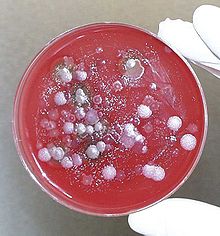
Back عامل حيوي Arabic Agent biològic Catalan چەکی میکرۆبی CKB Agente biológico Spanish جنگافزار میکروبی Persian Agent biologique French Agen biologis ID Agente biologico Italian Patogeninis mikroorganizmas Lithuanian Agente biológico Portuguese

Biological weapons are pathogens used as weapons. In addition to these living or replicating pathogens, toxins and biotoxins are also included among the bio-agents. More than 1,200 different kinds of potentially weaponizable bio-agents have been described and studied to date.
Some biological agents have the ability to adversely affect human health in a variety of ways, ranging from relatively mild allergic reactions to serious medical conditions, including serious injury, as well as serious or permanent disability or even death. Many of these organisms are ubiquitous in the natural environment where they are found in water, soil, plants, or animals.[1] Bio-agents may be amenable to "weaponization" to render them easier to deploy or disseminate. Genetic modification may enhance their incapacitating or lethal properties, or render them impervious to conventional treatments or preventives. Since many bio-agents reproduce rapidly and require minimal resources for propagation, they are also a potential danger in a wide variety of occupational settings.[1]
The 1972 Biological Weapons Convention (BWC) is an international treaty banning the development, use or stockpiling of biological weapons; as of March 2021, there were 183 States Parties to the BWC.[2] Bio-agents are, however, widely studied for both defensive and medical research purposes under various biosafety levels and within biocontainment facilities throughout the world.
- ^ a b "Biological Agents". United States Department of Labor: OSHA. Retrieved 2012-05-31.
- ^ Cite error: The named reference
:1was invoked but never defined (see the help page).
© MMXXIII Rich X Search. We shall prevail. All rights reserved. Rich X Search
